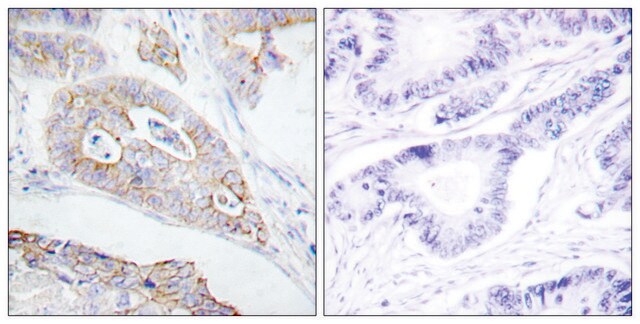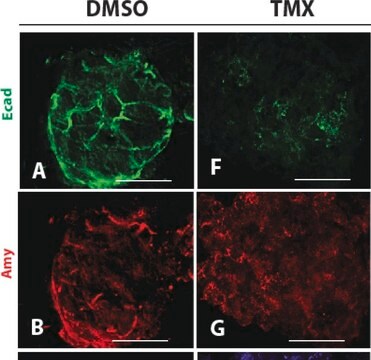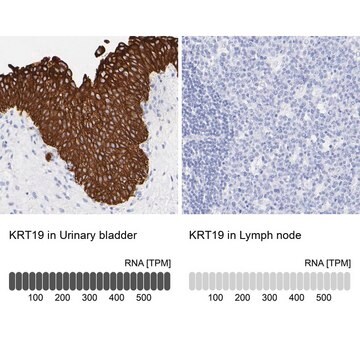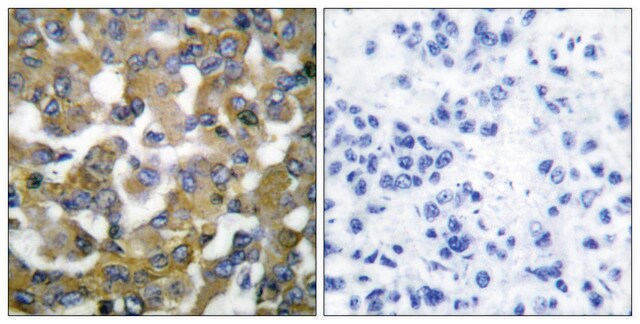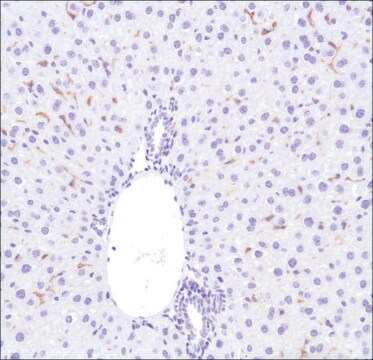MABT913
Anti-Cytokeratin 19 Antibody, clone TROMA-3
clone TROMA-3, from rat
Synonim(y):
Keratin, type I cytoskeletal 19, CK-19, Keratin-19, K19
About This Item
Polecane produkty
pochodzenie biologiczne
rat
Poziom jakości
forma przeciwciała
purified immunoglobulin
rodzaj przeciwciała
primary antibodies
klon
TROMA-3, monoclonal
reaktywność gatunkowa
mouse, human
opakowanie
antibody small pack of 25 μg
metody
electron microscopy: suitable
immunofluorescence: suitable
immunohistochemistry: suitable (paraffin)
immunoprecipitation (IP): suitable
western blot: suitable
izotyp
IgG2aκ
numer dostępu NCBI
numer dostępu UniProt
Warunki transportu
ambient
docelowa modyfikacja potranslacyjna
unmodified
informacje o genach
human ... KRT19(3880)
mouse ... Krt19(16669)
Opis ogólny
Specyficzność
Immunogen
Zastosowanie
Western Blotting Analysis: A representative lot detected Cytokeratin 19 in Western Blotting applications (Boller, K., et. al. (1987). Eur J Cell Biol. 43(3):459-68).
Electron Microscopy Analysis: A representative lot detected Cytokeratin 19 in Electron Microscopy applications (Boller, K., et. al. (1987). Eur J Cell Biol. 43(3):459-68).
Immunofluorescence Analysis: A representative lot detected Cytokeratin 19 in Immunofluorescence applications (Boller, K., et. al. (1987). Eur J Cell Biol. 43(3):459-68).
Immunohistochemistry Analysis: A representative lot detected Cytokeratin 19 in Immunohistochemistry applications (Takase, H.M., et. al. (2013). Genes Dev. 27(2):169-81).
Immunoprecipitation Analysis: A representative lot detected Cytokeratin 19 in Immunoprecipitation applications (Ichinose, Y., et. al. (1990). Biochem Biophys Res Commun. 167(2):644-7).
Jakość
Western Blotting Analysis: 0.5 µg/mL of this antibody detected Cytokeratin 19 in 10 µg of MCF-7 cell lysate.
Opis wartości docelowych
Postać fizyczna
Inne uwagi
Nie możesz znaleźć właściwego produktu?
Wypróbuj nasz Narzędzie selektora produktów.
Kod klasy składowania
12 - Non Combustible Liquids
Klasa zagrożenia wodnego (WGK)
WGK 1
Temperatura zapłonu (°F)
Not applicable
Temperatura zapłonu (°C)
Not applicable
Certyfikaty analizy (CoA)
Poszukaj Certyfikaty analizy (CoA), wpisując numer partii/serii produktów. Numery serii i partii można znaleźć na etykiecie produktu po słowach „seria” lub „partia”.
Masz już ten produkt?
Dokumenty związane z niedawno zakupionymi produktami zostały zamieszczone w Bibliotece dokumentów.
Nasz zespół naukowców ma doświadczenie we wszystkich obszarach badań, w tym w naukach przyrodniczych, materiałoznawstwie, syntezie chemicznej, chromatografii, analityce i wielu innych dziedzinach.
Skontaktuj się z zespołem ds. pomocy technicznej
